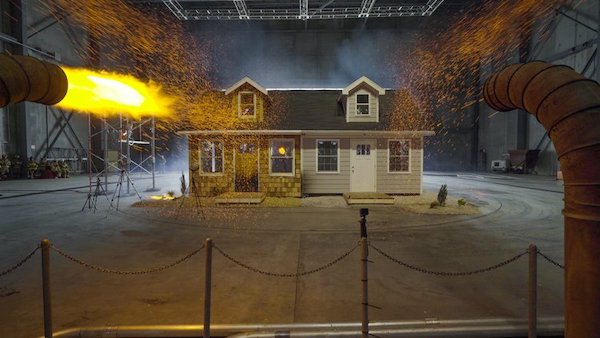SEJournal Online is the digital news magazine of the Society of Environmental Journalists. Learn more about SEJournal Online, including submission, subscription and advertising information.
 |
| A new documentary suggests that resources to fight major fires might be better used making more buildings fire-resistant. Above, a lab tests fire-hardened building materials for homes. Photo: Elementalfilm.com. |
EJ InSight: U.S. Wildfire Response Badly Off-Base, New Doc Convincingly Shows
By Robert McClure
As a journalist who has covered wildfire for decades, I was delighted to discover “Elemental,” an extraordinary new documentary that I hope will serve as a crucial turning point. This gripping doc should help move us toward a new and more sensible paradigm for Americans besieged by wildfire and smoke. And help protect the climate.
“Elemental,” a searing critique of current policies for dealing with wildfire, grabs the viewer by the lapels from the first moments with stunning cinematography, surveying fire horror scenes from the air, with voiceovers acknowledging the threat from two previous and one current president. (Biden: “This is a blinking code red for our nation.” Trump: “Hopefully this is going to be the last of these because this was a really, really bad one.” Obama: “The devastation is enormous.”)
The film forcefully brings the viewer
into the midst of the megafires that
have become an increasingly scary
feature of modern life in the West.
Then the film forcefully brings the viewer into the midst of the megafires that have become an increasingly scary feature of modern life in the West.
“There’s explosions everywhere! Oh my God, people’s tires are popping!” a breathless woman exclaims in one scene as she tries to escape the inferno.
“Jesus! There’s embers floating around all over around me!” a freaked-out man says in another scene. “This thing is going to light everything on fire. Look! They’re landing on the ground right there!”
Solid journalism with a point of view
“Elemental” is remarkable for how it deftly intersperses you-are-there video and audio with wonky, in-the-weeds revelations about science and policy. The viewer leaves with a realization that what we are doing in the United States to combat wildfires is simply not working.
The one-hour, 22-minute-long film has enjoyed a good reception as it made the summer film festival circuit, as well as screenings arranged for fire survivors, government officials, firefighters and others. (It next has an Oct. 15 spot at the Mill Valley Film Festival, notable for creating buzz among the movie-award cognoscente.)
Directed by filmmaker Trip Jennings and produced by Oregon attorney Ralph Bloemers, “Elemental” definitely has a point of view and a policy prescription (the latter detailed below). It’s also clearly a work of solid journalism, based on deep research, with an urgent message: We’re doing this wildfire thing all wrong.
“We’re not gaining. It basically tells us, in boldface, that we’re going in the wrong direction,” says Jack Cohen, veteran researcher from the U.S. Forest Service’s Fire Sciences Lab in Missoula, Montana, in one scene. (Cohen may be familiar to environmental journalists who joined him on a great western wildfire tour at the Society of Environmental Journalists 2010 annual conference in Missoula.)
Importantly, the film shows two politicians from the West, with a D and an R behind their names, promoting the long-standing idea of selective thinning of “overstocked” forests. And the film shows how that mindset doesn’t match the modern reality.
Fireproofing ‘an impossible task’
The first of my three principal takeaways from the documentary is that we are not going to be able to thin forests fast enough or prescribe-burn our way out of this. There’s just too much forest out there.
I came to this conclusion years ago at InvestigateWest when we toted up how little prescribed burning and thinning was going on in Oregon, compared to the overall amount of forest.
One study showed that only 1% of lands that were thinned and/or burned later experienced fires — it’s hard to predict where fires might occur. And even when those “treated” areas later became engulfed in a big fire, they very often proved ineffective as fuel breaks to slow or stop the fire.
‘The idea that we can fireproof
this huge landscape of flammable
material is simply an impossible task.’
— Tania Schoennegal,
Colorado landscape ecologist
“The idea that we can fireproof this huge landscape of flammable material is simply an impossible task,” Colorado landscape ecologist Tania Schoennegal says in the film. “It’s like trying to scoop out water out of the ocean to make it less wet. … These areas are just so vast in the West that there’s no way that we can remove enough trees to make them nonflammable.”
The bottom line for those of us living in the West: We must endure fires — big fires. There will be smoke.
Protecting buildings vs. containing fires
My second takeaway is that the money we are now pouring into what critics call the fire-industrial complex would be better spent protecting buildings from fire, rather than trying to contain most major fires.
Costs are mounting. The scale of the response to these fires has been growing rapidly in the conflagrations of recent years. “Elemental” doesn’t exhaustively explore this cost issue, but it does reference the thousands of firefighters mobilized for many major fires. These are major resource expenditures.
A better use of that money, the film suggests, would be making more buildings fire-resistant. Removing vegetation around buildings is also key to this approach. The “home ignition zone” generally stretches 100 feet from a structure, although it’s not always necessary to remove all plants and trees.
The film argues that spending money on prescribed burns and perhaps some thinning makes sense around populated areas. But, as previous reporting I’ve supervised shows, that’s where it’s the hardest to convince neighbors to allow proposed burns and thinning. This is a major challenge.
The carbon factor and older forests
My third takeaway — and the one most important for my current reporting — is that our present approach is a really bad deal for the climate. “Elemental” takes us up into the tree canopy with Oregon State University researcher Beverly Law, with four volcanoes in the background.
Her team has actually measured how much carbon dioxide is coming off of older forests with bigger trees, versus younger forests. She and her team are members of a 20-unit global research network.
And you know what? The long-prevailing assumption that older forests are sources of carbon, or at best are net-zero, is just wrong. Measurements by Law and others show that.
“We found that these forests are much more important than people imagined,” Law says in one scene. “Mature and old forests are the workhorses. They take up more carbon annually and they have a lot more stored in the wood” than younger forests.
It turns out younger forests are actually net carbon sources for their first 20 years, this research network’s work shows. The policy implication here: The U.S. Forest Service allows post-fire logging, also known as “salvage logging,” but most fires don’t kill a majority of trees, and leaving that carbon stored in the logs – alive or dead — is a far better deal for the climate.
Are wildland-urban fire disasters ‘inevitable’?
Other points “Elemental” makes well: In forests and some other ecosystems, fire serves as a rejuvenating factor, aiding numerous plants and animals. Commercial timber plots in one area highlighted in the film tended to burn more severely than adjacent government areas that have been managed more for conservation. And our climate is changing; the 1950s and 1960s, when the policy was to put out every wildfire asap, were wetter and cooler than today’s climate.
Some ideas explored in “Elemental” are not new, such as the notion that protecting buildings makes more sense than seeking to fireproof forests. For example, Roger Kennedy’s 2006 book “Wildfire and Americans” argued that Americans were moving into places they should not be because of fire risks. And Cohen of the Missoula Forest Service lab has been sounding this theme at least since the 1990s.
“It’s a home-ignition problem, not a wildfire-control problem” as Cohen says in the film.
He goes on: “I have a high level of confidence that we can prevent community fire destruction during extreme wildfires because the research that has gone on for the last 30-plus years shows us we have the opportunity to prevent big community fire disasters. But if we continue our current emergency-response approach, wildland-urban fire disasters will be inevitable.”
“Elemental” is expertly informed by recent research. And it’s a compelling new look at how to get Americans to start thinking about this important but easily-ignorable topic.
[Editor’s Note: A virtual screening of “Elemental” for members of the Society of Environmental Journalists and other journalists will be available Feb. 15 at 1 p.m. ET. Pre-register here: https://bit.ly/3RRbbZV. Meanwhile, for more resources on covering wildfires, check out our Topic on the Beat: Wildfire page and get the latest wildfire headlines from EJToday.]
Robert McClure is an independent journalist living in Seattle, where he was co-founder, executive director and executive editor of InvestigateWest, a journalism studio focused on the environment, public health and government accountability from 2009 to 2021. He also served on the SEJ Board of Directors for 12 years and serves as chair of the SEJ Editorial Advisory Board. He’d love to talk more about the topic of wildfires and hear ideas about how to take this discussion forward at the SEJ’s 2023 conference in Boise. And he’d be happy to hear from SEJers and others interested in seeing a screening.
* From the weekly news magazine SEJournal Online, Vol. 7, No. 36. Content from each new issue of SEJournal Online is available to the public via the SEJournal Online main page. Subscribe to the e-newsletter here. And see past issues of the SEJournal archived here.













 Advertisement
Advertisement 



